Executive Summary
This report aimed at analysing three aspects of the Lobby Café Construction project, including external factors affecting the project, stakeholder analysis, and assessment of ethicality and corporate social responsibility (CSR). The purpose of the project was to build the Lobby Café in The Pearl Hotel & Residences, a hotel located in Doha, Qatar. The project was delivered between September 2018 and December 2018 with a budget of 250,000 QR.
First, external analysis was conducted using PEST analysis and Porter’s Fiver forces analysis to understand the external environment of the project. Numerous political, economic, social, and technological factors that influenced the project were identified. Second, stakeholders were identified and categorised using the stakeholder matrix. Stakeholder analysis revealed that the team sued exquisite stakeholder management practices to achieve the purpose of the project. Finally, CSR practices were analysed, which demonstrated that the company acted proactively to build strong relationships with the stakeholders through promoting ethical practices.
Introduction
Report Objectives
This report aims at evaluating the Lobby Café Construction project from three viewpoints. The purpose of the report is to provide a list of recommendations that can be used for implementing similar projects in the future. Several objectives were identified that helped to reach the goal of the study:
- Briefly describe the project, its location, and relevance;
- Identify external factors that affected the project;
- Analyse stakeholders;
- Critically appraise the role of ethics and Corporate Social Responsibility (CSR).
First, the report discusses the external influence that affected the implementation of the project using PEST analysis and Porter’s Five Forces analysis. Second, the influence of different stakeholders is analysed using Mendelow’s Matrix to understand if the project was managed adequately. Third, the report provides a discussion of how the project delivered benefits to the community in terms of CSR. The report is concluded with a list of recommendations outlined based on the results of the analysis.
Project Description
The purpose of the project was to build the Lobby Café in The Pearl Hotel & Residences, a hotel earned by First Qatar Real Estate Development Company (1st Qatar), a B2C company with roots in Kuwait. The hotel is located in Doha, the capital city of Qatar, with a population of 2.4 million people. The aim of the project was to build a new café on the territory of the hotel with a budget of 250,000 QR. The project started in August 2018 and finished in December 2018, which implies that the length of the project was four full months. Project scope and deliverable can be described as the complete construction of the cafe with the exact specifications required by the client. The client of the project was Doha Hilton, The Pearl Hotel & Residences.
By building Lobby Cafe, a new product was successfully delivered after completion. The project provoked a significant increase in the level of competition in the cafe market, resulting in improved quality of service. Additionally, new job opportunities were provided, which influenced the level of supply in the job market. The café was also expected to attract new customers to the hotel and help to meet the needs of the current customers. A photo of the Lobby Café is provided in Figure 1 below.
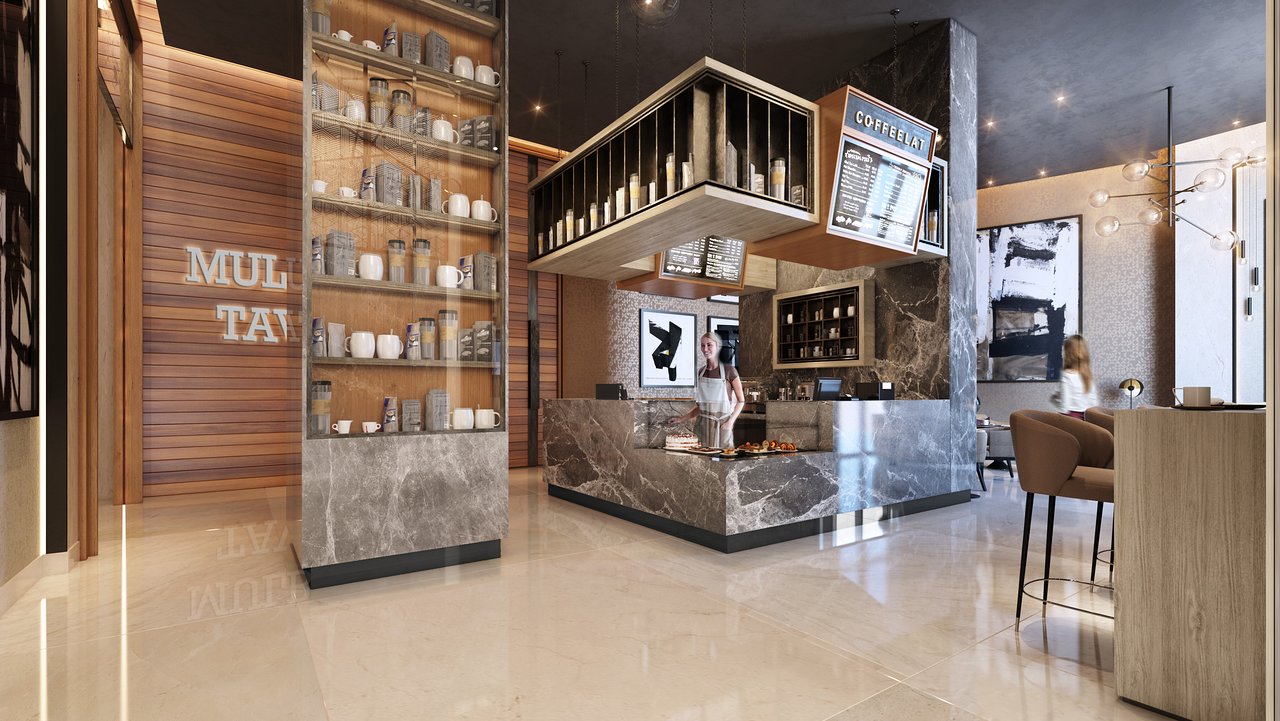
External Analysis
This section of the report aims at conducting an analysis of the external factors that affected project implementation. First, a PEST analysis was conducted to outline the factors affecting the project. The PEST analysis included an assessment of macroeconomic and microeconomic factors that affected the project. Second, Porter’s Five Forces analysis was conducted to understand how different stakeholders, including competitors, suppliers, and buyers, affected the project. The results of the assessment of the external environment will be used for stakeholder analysis provided in Section 3 of this report.
PEST Analysis
PEST analysis is one of the most frequently used methods for conducting environmental scans. PEST analysis includes the evaluation of political, economic, social, and technological factors that affect a business (Dalirazar and Sabzi, 2020). The pest analysis was conducted with the assumption that The Pearl Hotel & Residences operated in the hospitality business of Qatar.
Political Factors
The central factor that affected the hospitality business in Qatar was the preparations for FIFA World Cup 2022 (Alshahrani et al., 2021). Since it was decided that the championship will take place in Qatar, a large number of visitors started to arrive in Qatar. According to Statista (2021), the number of tourists increased from 1.7 million in 2010 to 2.94 million in 2016. Since the number of visitors was growing, it was crucial to build the Lobby Café was imperative to meet the needs of the customers (see Figure 2 below).
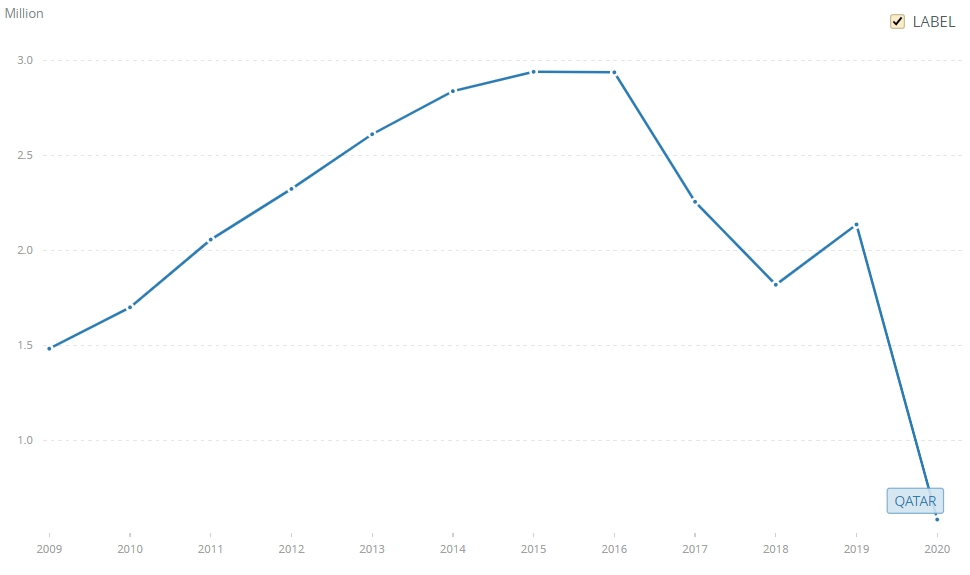
In 2018, Qatar experienced significant pressure from its neighbours as a result of the blockade. Saudi Arabia, Bahrain, the United Arab Emirates, and Egypt stated that the country had significant human rights issues and demanded significant reformation (Human Rights Watch, 2018). As a result, the number of tourists in the country decreased from 2.94 million in 2016 to 1.82 million in 2018, which was a significant shock to the industry. However, the GCC hospitality industry expected a significant rise, which could mitigate the consequences of the blockade (Alpen Capital, 2018).
Economic Factors
A large variety of macroeconomic and microeconomic factors affected the project. An in-depth analysis of these factors is provided in Table 1 below.
Table 1. Economic Factors
Social Factors
There are two central social factors that affect the hospitality industry. First, young people make it a priority to travel rather than buy things. According to a survey conducted by CNBC, more millennials were saving up money for travelling in comparison with any other generation (Leonhardt, 2019). The results of the survey are demonstrated in Figure 2 below. Young generations are looking for new places to visit, and Qatar can be a destination of choice due to FIFA World Cup 2022.
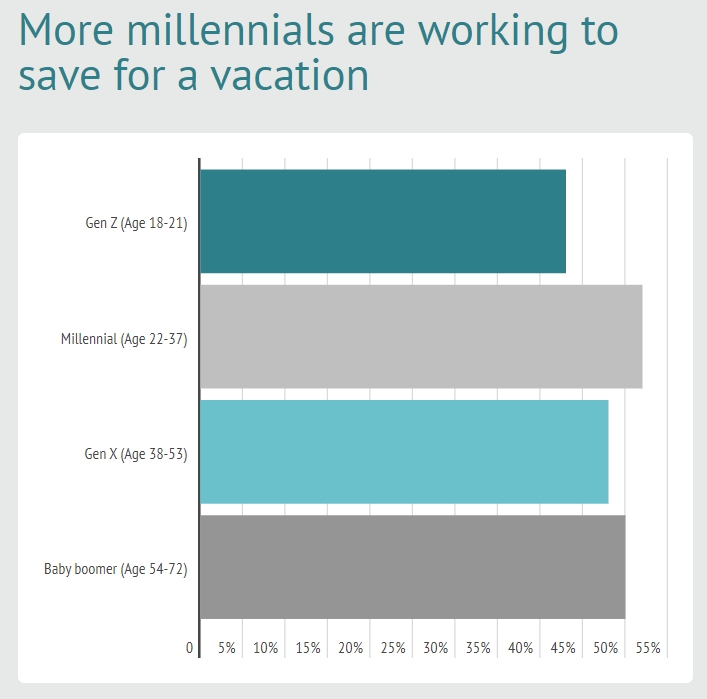
The second trend that affected the hospitality industry is the push for sustainability in the industry. Alpen Capital (2018) stated that tourists become more aware of the environmental problems as people want to pass the natural and cultural riches to future generations. Thus, organisations in the hospitality industry tend towards transforming their operations to attend to sustainability goals.
Technological Factors
The hospitality industry nowadays uses a wide variety of technological advances, as they have become essential for the customers. Such technology as Wi-Fi for connectivity and CTTV cameras for protection is widely used in the industry. However, the central technology that affected the industry the most was online booking and ranking systems (Gavilan, Avello, and Martinez-Navarro, 2018). Online ranking creates an image of a hotel based on the reviews from the visitors. Thus, the hotels are motivated to improve their rankings using all the available methods.
Porter’s Five Forces
Porter’s Five Forces analysis is a commonly used method for assessing the strengths and weaknesses associated with the industry in which the company operates (Bruijl, 2018). The framework aims at assessing five aspects of the external environment, including the threat of new entrants, the threat of substitution, the bargaining power of suppliers, the bargaining power of buyers, and competitive rivalry (Bruijl, 2018). The results of the analysis are provided below:
- Threat of New Entrants – Medium: On the one hand, new entrants in the hospitality industry are possible due to increased interest in Qatar as a destination for FIFA World Cup 2022. However, there are significant entry barriers, as the initial investment to enter the luxury hotel industry should be large and the new hotels need to build a reputation, unless they are established by a well-known hotel network.
- Threat of Substitution – Medium: Hotels can be substituted by hostels, rental apartments, or Air BNB. However, the substitutes are underdeveloped in Qatar, and they cannot provide luxury services similar to Doha Hilton The Pearl Hotel & Residences.
- Bargaining Power of Buyers – High: The customers have a large variety of options for staying, which makes them a significant power affecting the industry. The influence of the customers is clear when taking into consideration the power of online feedback and rankings (Gavilan, Avello, and Martinez-Navarro, 2018). Thus, hotels make everything possible to please the customers.
- Bargaining Power of Suppliers – Low: The number of suppliers is high, and hotels are free to select the ones they prefer based on any criteria. Therefore, suppliers do not have a high power over the Doha Hilton The Pearl Hotel & Residences.
- Competitive Rivalry – High: The scan of competitors revealed a hectic competitive environment in the industry. The PEST analysis also demonstrated fierce competitive rivalry in the industry.
The summary of Porter’s Five Forces analyses is provided in Figure 4 below.
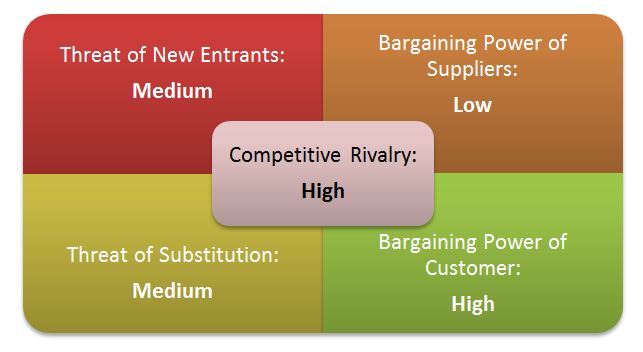
Stakeholder Analysis
Internal and External Stakeholders
Stakeholder management is an extremely important part of project management, as it helps to understand how to minimise resistance from stakeholders with an optimal amount of effort (Pedrini and Ferri, 2019). There are two general types of stakeholders, including internal and external stakeholders. Internal stakeholders are people whose interest is directly related to the performance of the company (Fernando, 2021). In other words, internal stakeholders are people directly affected by the project due to close ties, such as employment, ownership, or investors (Fernando, 2021). Thus, the internal stakeholders included the owner of the hotel and the café, which is the Kuwaiti-backed 1st Qatar construction company, shareholders, as they are the investors of the company, and the personnel, as they are connected with the company through employment. It is crucial to mention the project team as a special kind of employee of the company, as these stakeholders are directly engaged in the project implementation.
External stakeholders are the people and organisations that are affected by the project indirectly (Fernando, 2021). External stakeholders include suppliers, creditors, customers, communities, and public organisations (Fernando, 2021). For this project, the bank, contractors, suppliers, customers, and local government were identified as the external stakeholders of the Lobby Café building project. The government deserves special attention, as it is difficult to classify as the internal or the external stakeholders. In Qatar, the government often has a direct influence on business, as it is usually the central shareholder of companies. It may be assumed that the Qatari government owns the company’s shares, which makes the government an internal stakeholder. Table 2 below provides a list of all the stakeholders by their status.
Table 2. Stakeholder list
Stakeholder Matrix
The stakeholder matrix, also known as Mendelow’s Matrix, suggests that stakeholder groups are analysed based on their level of power and level of interest (Meredith and Mantel, 2011). The framework views the level of power as the ability of the stakeholder to influence the project directly or indirectly (Meredith and Mantel, 2011). At the same time, interest is measured based on how concerned the stakeholder is with the success of the project (Meredith and Mantel, 2011). The division of stakeholders based on this criterium is provided in Figure 5 below.
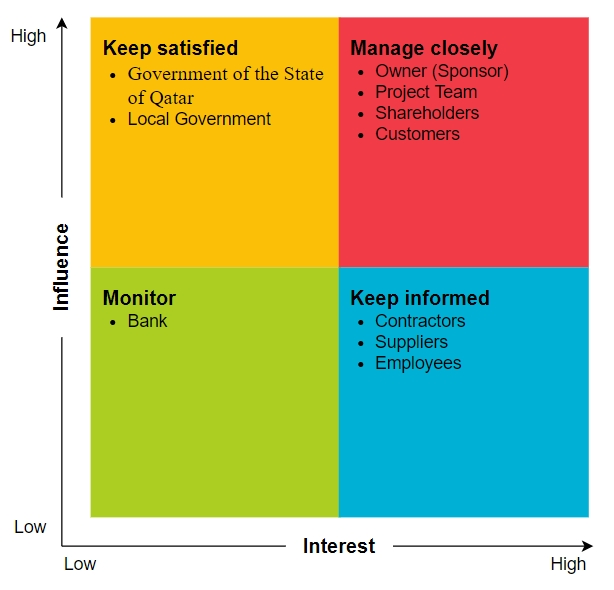
According to Mendelow’s Matrix framework, the key stakeholders that needed to be managed closely were the owner, the project team, the shareholders, and the customers. The owner financed the project and could directly influence the project by setting the objectives and giving tasks. The shareholders could influence the decisions of the owner of the project, 1st Qatar, which could affect the flow of the project. Both the owner and the shareholders were interested in the success of the project, as it was expected to affect the profitability of the company and its reputation. The customers had a high interest in the project because they wanted to receive a high level of services. At the same time, the customers were free to demonstrate their expectations based on their needs. Finally, the project team could directly affect the flow of the project, and they were interested in its success, as the team’s reputation and pay depended on it. Therefore, these stakeholders needed to be managed carefully through frequent effective communication, constant analysis of wants and needs, providing progress reports, and a personal approach (Meredith and Mantel, 2011).
The bank’s interest was only in the company’s ability to pay the current portions of debt. Additionally, the bank had the power to affect the project only in specific cases when the owner did not fulfil its obligations. Therefore, the bank needed to be monitored to ensure that all the obligations were fulfilled (Meredith and Mantel, 2011).
The contractors, suppliers, and employees were interested in the outcomes of the project, as they could befit from the success of the project financially. However, that cannot affect the project by any other means except failing to provide the services in time or altering the cost of their service. Therefore, these stakeholders needed to be informed about the project’s success through frequent communication (Meredith and Mantel, 2011).
The state government and the local authorities had a significant influence on the project, as they were authorised to interfere directly. However, the government had little direct interest, as it was interested only in the project complying with all the rules and regulations. Thus, the Government of the State of Qatar, along with the local government were, needed to be satisfied (Meredith and Mantel, 2011).
Corporate Social Responsibility
Concept of Corporate Social Responsibility
Corporate Social Responsibility (CSR) is defined as “practices and policies undertaken by corporations intended to have a positive influence on the world” (Fernando, 2022, para 12). CSR is a concept that helps companies to stay socially accountable to all the stakeholders (Fernando, 2022). CSR is helpful for both the companies and the communities. On the one hand, the community receives benefits in different forms, such as a better environment and the promotion of health and safety. According to Latapí Agudelo, Jóhannsdóttir, and Davídsdóttir (2019), CSR is usually demonstrated in the fight against discrimination, health promotions in the communities, and improved waste management. On the other hand, the company benefits from CSR as it builds positive relationships with the customers and authorities by improving its reputation (Fernando, 2022). Even though CSR may be a costly endeavour, it is a crucial part of the operations of modern-day companies.
CSR and Ethics in Lobby Café Construction
The project team demonstrated that they wanted to contribute to the local community and the Qatari society on several levels. First, it is beneficial to look at the level of project implementation. It is crucial to notice that the owner promoted ethicality during the implementation project by ensuring the absence of any discrimination on the construction site. The project team monitored the practices of the contractors to ensure that workers were not discriminated against. The project team ensured that all the supplies were received from ethical sources, which were the suppliers that did not exploit their workers or harm the environment to receive higher income. Additionally, the project team protected the health of the construction workers through health and safety training and regulations. The company provided special training to all the employees and contractors concerning the safety measure on the construction site. The project team also ensured that all the construction workers were protected from heat and did not work in the open between 11 AM and 4 PM. Thus, the project demonstrated its CSR and ethical behaviour through care for all the stakeholders during the project implementation.
The project team also ensured that the café operated in an ethical way. First, the café was dedicated to managing its waste effectively. All the cups were made from recycled materials and the café also promoted the recycling of PET and glass bottles. Second, the café provided jobs for women, which demonstrated the company’s position in terms of discrimination. Finally, the company promoted ethicality in relations with the suppliers. In particular, the café ensured that all the supplies for the café, such as food, drinks, dishes, furniture, silverware, etc., were sourced from socially responsible suppliers.
It is crucial to notice that the project team did not only follow the regulations of the government but exceeded them in demonstrating social responsibility. For instance, the heat protection laws in Qatar prohibit working in the open between 11.30 AM and 3 PM (Human Rights Watch, 2018). However, the company changed this standard to ensure the protection of the workers. Similarly, the project team increased the standards of waste management, which was not required by the government. In other words, instead of being reactive to outside pressure, the project team was proactive. The project management team built strong relationships with all the key stakeholders, including the community, monitored their expectations and ideas about ethicality and CSR, and implemented CSR practices accordingly.
Conclusion
This report provided a detailed analysis of the Lobby Café Construction project from three viewpoints, including external influencers, stakeholder analysis, and CSR practices. First, the assessment demonstrated that the project was influenced by a wide variety of economic, political, social, and technological factors. The most influential factors included the increased attention to Qatar due to FIFA World Cup 2022, growing demand for services, the blockade, and increased influence of online rankings of hotels. Second, the report identified all the stakeholders and divided them between internal and external, as well as classified them according to the stakeholder matrix. The results of the analysis revealed that stakeholder management practices were outstanding. Finally, the assessment of CSR practices demonstrated that the project management team made every effort to build strong relationships with the stakeholders by promoting ethical practices during and after the implementation of the project.
Reference List
Al-Khalaf, E. and Choe, P. (2019) Increasing customer trust towards mobile commerce in a multicultural society: A case of Qatar. Journal of Internet Commerce, v.19 (1), pp.32-61.
Alpen Capital (2018) GCC Hospitality Industry [online]. Web.
Alshahrani, N. et al. (2021). FIFA World Cup 2022 in Qatar; Health Advice and Safety Issues for Travelling Attendees. Annals of Medical and Health Sciences Research, v.11 (S2), pp. 417-422. Web.
Bruijl, G. H. T. (2018) The relevance of Porter’s five forces in today’s innovative and changing business environment [online]. Web.
Dalirazar, S. and Sabzi, Z. (2020) Strategic analysis of barriers and solutions to development of sustainable buildings using PESTLE technique. International Journal of Construction Management, pp. 1-30.
Human Rights Watch (2018) Qatar: Events of 2018 [online]. Web.
Fernando, J. (2021) Stakeholder [online]. Web.
Fernando, J. (2022) Corporate Social Responsibility (CSR) [online], Web.
Gavilan, D., Avello, M., and Martinez-Navarro, G. (2018) The influence of online ratings and reviews on hotel booking consideration. Tourism Management, v.66, pp. 53-61.
Kapar, B. and Buigut, S. (2020) Effect of Qatar diplomatic and economic isolation on Qatar Stock Market Volatility: An event study approach. Applied Economics, v.52 (55), pp.6022-6030.
Latapí Agudelo, M. A., Jóhannsdóttir, L., and Davídsdóttir, B. (2019) A literature review of the history and evolution of corporate social responsibility. International Journal of Corporate Social Responsibility, v.4 (1), pp. 1-23.
Leonhardt, M. (2019) Millennials are making travel a priority more than previous generations—that’s not a bad thing. CNBC [online]. Web.
Luo, J. M. and Lam, C. F. (2020) Travel anxiety, risk attitude and travel intentions towards “travel bubble” destinations in Hong Kong: Effect of the fear of COVID-19. International Journal of Environmental Research and Public Health, v.17 (21), article 7859.
Meredith, J. R. and Mantel S. J. (2011) Project management: a managerial approach, 8th ed, Wiley.
Qatar Planning and Statistics Authority (2021) Monthly Figures on Total Population [online] Web.
Pedrini, M. and Ferri, L. M. (2019) Stakeholder management: a systematic literature review. Corporate Governance: The International Journal of Business in Society, v.19 (1), pp. 44-59. Web.
Skyticket (2019) Doha: Must-see Attractions in the Capital of Qatar [online]. Web.
Statista (2021) Number of tourists to Qatar from 2008 to 2020 [online]. Web.
Tripadvisor (n.d.) Photo: Lobby Café [online image]. Web.
World Bank (2022) International tourists number arrivals [online image]. Web.